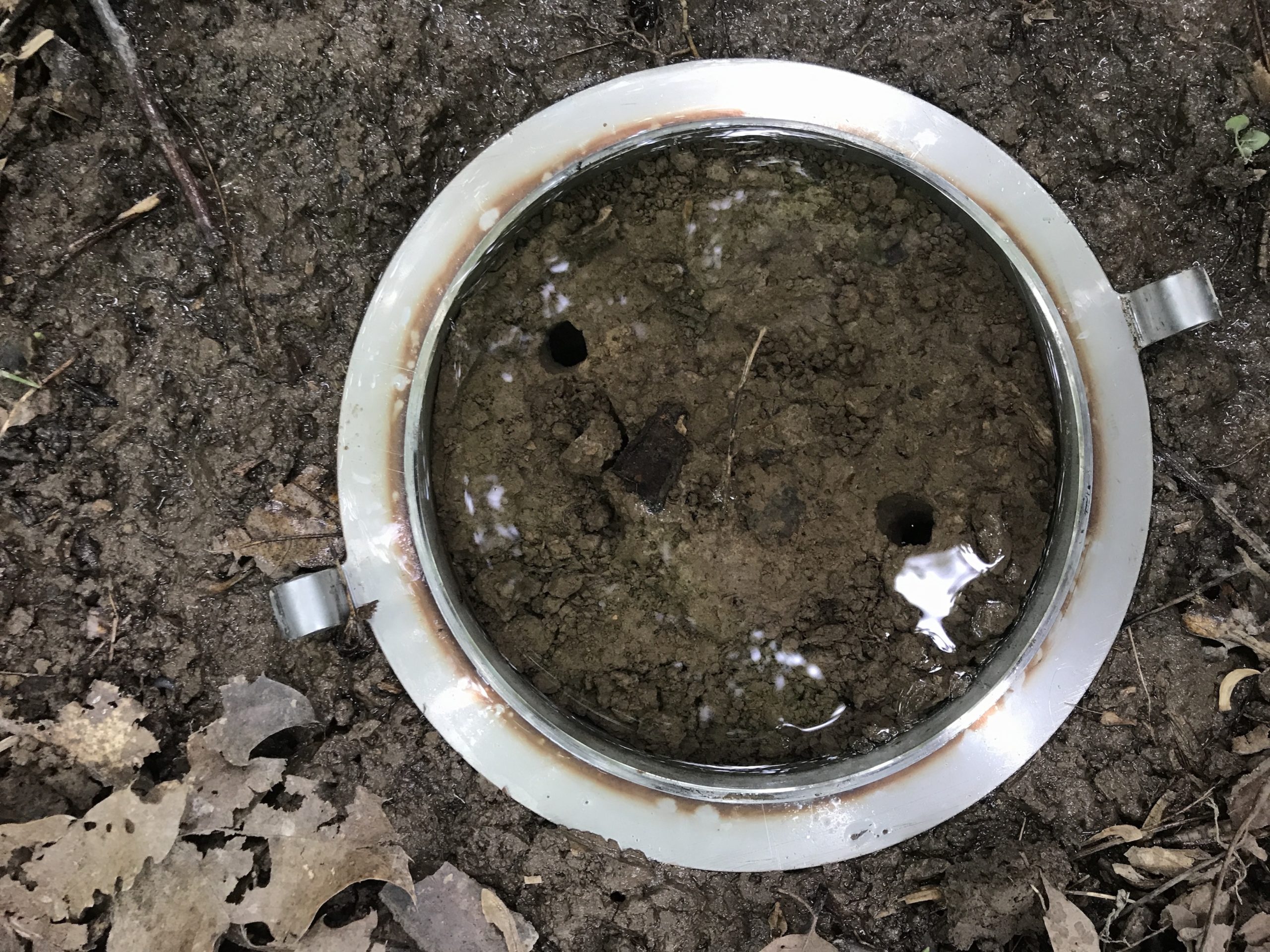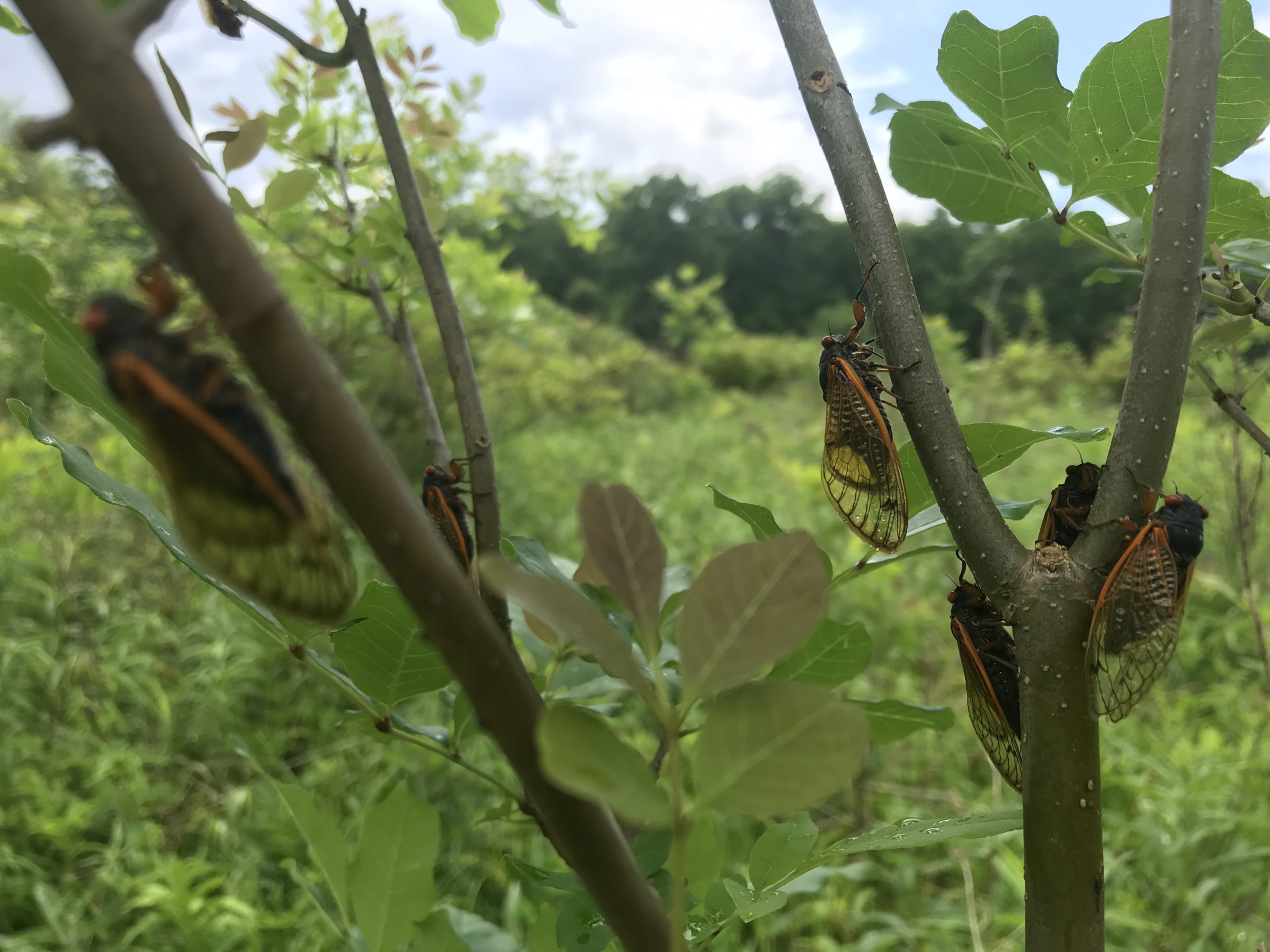Billions of cicada emergence holes increased the infiltration of water into soils, potentially affecting vegetation, groundwater
13 December 2021

Two cicada emergence tunnels remain submerged within the infiltrometer ring after a measurement of the soil’s infiltration rate.
Credit: Ellen Bergan.
AGU press contact:
Liza Lester, +1 (202) 777-7494, [email protected]
Contact information for the researchers:
Ellen Bergan, Department of Geography, Indiana University – Bloomington, [email protected], +1 (812) 219-9050
Darren Ficklin, Department of Geography, Indiana University – Bloomington, [email protected] +1 (812) 856-5047
NEW ORLEANS—Long after the deafening cacophony of the Brood X cicadas ended in mid-June, their ecological legacy was still playing out underground, according to a new study of cicada burrow-riddled ground being presented at the AGU Fall Meeting. The research found that the little holes in the ground left behind by emerging cicadas had a significant impact on how water penetrated soils, with the greatest effects in areas away from human activities.
When multiplied by billions of emergence burrows, the change in infiltration on such a vast scale for even a few weeks or months demonstrated how any kind of soil disturbances—even very infrequent events like Brood X—can affect vegetation, runoff, groundwater recharge rates and surface and groundwater quality.
“We looked at the effects long after their little screaming bodies were gone,” said Ellen Bergan, a research assistant in the Geography Department at Indiana University Bloomington, who worked on the project under the direction of associate professor Darren Ficklin. Bergan will be presenting a poster on the study on Monday, 13 December from 3:00-5:00 p.m. at AGU Fall Meeting 2021.

A group of Brood X cicadas, just a handful of the billions that emerged throughout the Midwestern and Eastern United States this past summer, cling to the branches of a tree near Bloomington, Indiana.
Credit: Ellen Bergan.
The Brood X cicadas are an endemic insect that emerge from the ground every 17 years from Indiana east to the mid-Atlantic states. They mate, lay eggs and die within several weeks, by mid-June.
Using an instrument called an infiltrometer, the research team examined differences in water infiltration rates between sites that had many cicada emergence holes and nearby sites with few holes in central Indiana – one of the hotspots of Brood X emergence. They also looked at the Brood X emergence holes across different land uses, comparing undisturbed sites in forests and preserves to more heavily used and disturbed areas like city parks.
They found the borrows significantly increased the water infiltration rates, but only at the sites undisturbed by human activities. The likely explanation for the difference, Bergan said, is that in more disturbed areas the soils tend to be more tamped down and compacted. This causes burrows to collapse more quickly than in undisturbed areas.
“We saw the infiltration rates decrease over time due to the holes filling with sediment and debris — but we saw a more rapid decrease in infiltration at disturbed locations due to them being more exposed to the elements,” Bergan said.
# # #
AGU (www.agu.org) supports 130,000 enthusiasts to experts worldwide in Earth and space sciences. Through broad and inclusive partnerships, we advance discovery and solution science that accelerate knowledge and create solutions that are ethical, unbiased and respectful of communities and their values. Our programs include serving as a scholarly publisher, convening virtual and in-person events and providing career support. We live our values in everything we do, such as our net zero energy renovated building in Washington, D.C. and our Ethics and Equity Center, which fosters a diverse and inclusive geoscience community to ensure responsible conduct.
*****
Notes for Journalists
Ellen Bergan will present this research in person on Monday, 13 December during a poster session at the AGU Fall Meeting 2021. For information about AGU Fall Meeting 2021, including press registration and the schedule of press events, visit the online Media Center. Neither the presentation nor this press release is under embargo.
Presentation abstract:
H15N-1205 – Influence of the Brood X Cicada Emergence on Soil Water Infiltration Rates
Monday, 13 December 2021, 16:00 – 18:00 CST
Session information:
H15N – Runoff Generation Processes: Integrating Observations and Processes Over Variable Scales III Poster